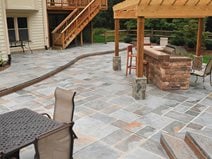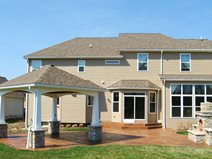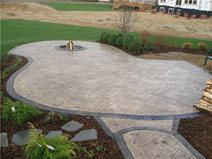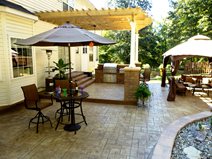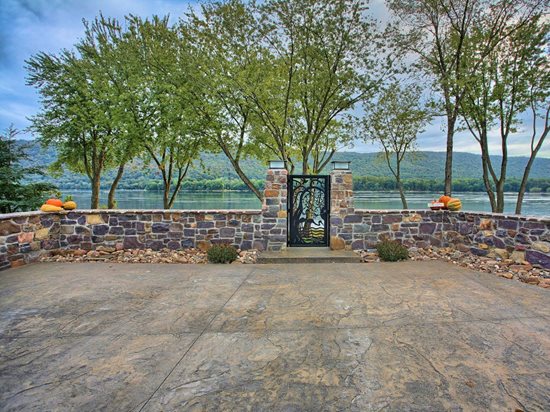My first hands-on exposure to installing
stamped concrete was back in 1976 at the innocent age of 14. I was working for my father at the time, helping him stamp a crosswalk in the busy downtown area of Alameda, Calif. The brick-pattern stamps we were using were made of plastic, and to prevent them from sticking to the fresh concrete, we stamped through a layer of 1-mil plastic. Once the stamping was complete, we added texture by dragging a broom across the surface.
We are a full service Calgary concrete company specializing in decorative concrete with over 30 years experience (15 in the Calgary market alone). During our time in Calgary, we have poured literally thousands of driveways, garage pads, patios, and basements. I know how stressful it can be trying to find a contractor that you can trust. With my experience and dedication to customer service, South Island Concrete will help take the stress out of your concrete project. I consider myself to be an honest, reliable, and professional with a commitment to quality workmanship that I stand behind 100 percent. No job is too big or too small. If you only need a broom sidewalk or small stamped patio all the way up to ripout and replace, I am happy to come talk to you and give you a free quote.
Roughly 30 minutes after completing the stamping for the day and setting up lighted barricades strung with "caution" ribbon, a little old lady with bluish-gray hair, driving a car in which she could barely see over the dashboard, crashed through the barricades and drove through the freshly stamped section. The funny thing was, she never even stopped. I can still vividly see her turning the corner down the street, dragging behind a piece of caution ribbon stuck to her bumper. And yep, you guessed it. We had to remove half of that day's pour, which my dad was not happy about.
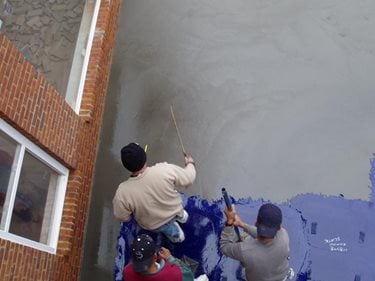
Decorative Concrete Institute in Temple, GA
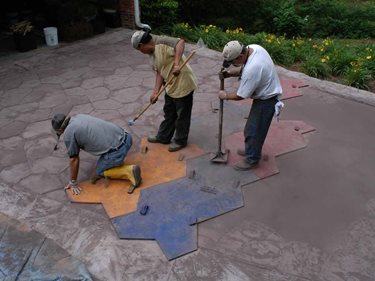
Decorative Concrete Institute in Temple, GA
Little did I know, that day would actually set the stage for my career in decorative concrete. A decade or so later, in the late 1980s and early 90s, I was pretty much stamping daily. One project we worked on involved stamping every driveway and pool deck for 350 homes in a new subdivision. Each prospective homebuyer had the choice of five different patterns to choose from, along with five different color options. This type of work, done in such a repetitive fashion, was a great learning experience. We were able to figure out how to overcome any obstacle thrown at us, making us experts in touchups and repairs. After several years of residential stamping, we moved into the big leagues of stamped concrete, doing commercial themed stamping for Disney World in Orlando, Fla., for close to 10 years, while hanging out with Mickey and friends. Any imaginable situation could arise at any moment in this type of environment, which taught us to become consummate professionals.
Throughout this entire time, I consistently encountered eight recurring considerations for a successful stamped concrete installation that made the difference between blasé and magical results. Certainly there are plenty of other considerations on a stamped concrete project, but these eight in particular always make the top of my list.
1. Adequate subgrade preparation
My golden rule:
Always place the subbase level, without variances in height. This is to ensure that the concrete is placed at a uniform thickness. Otherwise, it will not set at the same rate and you could get plastic shrinkage cracking in the thicker areas during stamping due to the differential setting times.
One of the most important aspects of any concrete installation is properly preparing the subgrade. Unfortunately, subgrade preparation is often overlooked and can lead to soil erosion and cracking of the concrete slab. In coastal regions, some contractors will even pour concrete right over the top of a sand base. Not only is it difficult to keep the sand flat and level during concrete placement, if you have to back a fully loaded concrete truck through the sand, ruts are inevitable.
For our subbases, we use a compacted, crushed granular fill. Typically, we install the fill at the same thickness as the concrete being poured, excavating the soil down to the thickness needed before placing the fill. A subbase, when installed properly, should be able to support a fully loaded concrete truck without rutting more than ¼ inch.
2. Using the right mix design
My golden rule:
The best mix design is the one that works in your area and fulfills your needs.
The concrete mix is probably one of the most misunderstood aspects of stamping, especially for newcomers to the process. Concrete is not a generic product that is the same from pour to pour. I always tell my students that no concrete, anywhere in the world, is the same from batch to batch. Most professional stamping contractors have several mixes they like to use under different circumstances, such as weather conditions and the size of the project. Contractors may have a mix design that is better suited for use during the summer because it's designed to set more slowly, while using a different mix in the winter that's designed to set faster. We even have an interior floor mix we use for thinner applications of less than 2 inches.
It also is imperative to establish a relationship with ready-mix producers and let them know the specifics of your requirements, such as the amount of cement, amount and type of sand, and how quickly you need the concrete to set. For stamping work, you typically want what we refer to as a "fatty" mix, one with a sufficient amount of cement paste to provide a layer of cream on the surface. If you use a mix without sufficient cream and too much coarse aggregate (referred to as a harsh mix), you will fight it through every step of the stamping process. While it's your responsibility to know and understand your concrete mix, there are prepackaged products you can use in a pinch to help you during the stamping process, such as
premeasured admixtures you can add to concrete on the jobsite to give you greater control over setting times. Also, in dry windy conditions, you can spray an evaporation retardant on the concrete surface to help prevent rapid drying.
3. Concrete placement
My golden rule:
Start small and don't try to tackle 20 cubic yards of stamping work in one shot, especially if you are new to the process. Start by placing 5 to 6 cubic yards, and then once you can successfully cover areas this size, move on to tackling larger areas.
There are a number of ways you can place the concrete once it arrives at the worksite. Most concrete finishers will tell you that when the truck pulls up on the site, their heart rate goes up because it's imperative for them to off-load that truck as quickly as possible. At this moment, it's as if nothing else in the world matters and your goal is to get that concrete on the ground. In order to do this, you need to start the stop watch map the moment the concrete truck leaves the plant and map out a pathway and keep it clear of obstructions, so the truck driver can pull into the placement area without interference. The longer the concrete mix sits in the truck, the greater the heat of hydration that develops, causing rapid setting.
Just as important as getting the concrete placed quickly is to strike off and finish the concrete quickly as well. The work you do immediately following concrete placement is critical since this is when you create the canvas for decorative stamping. One of the biggest problems I see for newbies is not having enough skilled workers on hand to place the concrete expeditiously.
4. Having enough stamps
A problem I often see with those new to stamping, and even with seasoned veterans, is trying to save money upfront by purchasing the minimum number of stamping tools. This can come back to bite you later if you encounter a situation where the concrete sets faster than you can stamp the surface. The general rule is to have enough stamps to span the widest area, plus two additional stamps. For example, if you are stamping a 20-foot-wide driveway and your stamps are 2x2 feet, you would need 10 stamps to span the first row, plus two additional stamps to start the second row, for a total of 12 stamps. I know of one commercial stamped concrete contractor in Pennsylvania that doesn't stamp jobs smaller than 1,000 square feet. He has as many as 25 to 30 tools per set, enabling him to stamp these large areas very quickly. Remember, not only will you need enough stamping tools, you will also need accessory items such as hand chisels, tampers, detail rollers and a sufficient amount of concrete finishing tools.
5. Understanding color theory
Another challenge for some contractors is understanding color theory and the important role it plays on any project. By selecting the right color schemes for stamped concrete, you will create an environment of ambiance and harmony. Conversely, selecting the wrong color combination leads to a stamped concrete installation that doesn't make sense and fails to blend harmoniously with the surroundings. When used effectively, good color selection can be one of the most powerful design elements on your projects. When I'm asked to give recommendations on color selections, one of the first things I do is study the colors of the structural elements on the home or building, such as the colors of the roof, the siding, and the window trim. By incorporating these hues or complementary tones into your stamping work, your work will blend in naturally. For example, you might consider using the color of the roof as a base color and use accent colors that match the colors of the trim or siding. On larger projects, color schemes may be dictated by the project architect or designer. But often your clients will give you full creative license to come up with your own color schemes. If this is the case, make sure you discuss your intentions first, and more importantly, produce representative samples for the client to approve.
6. Applying sealer
My golden rule:
Don't be impatient and apply sealers too early or too thickly in one coat. Be sure to read the sealer manufacturer's specifications and adhere to the guidelines for when to apply the sealer and how long to wait between coats. Trust me, it will save you many headaches and even a few hairs, if you're lucky.
No decorative stamped concrete installation is complete without the application of a sealer. This is probably one of the most controversial issues in the business, and one that gives contractors the biggest headaches. When I started in the business, I used to have a full head of hair. Not now! In all seriousness, we have been fortunate and have not encountered many of the problems with sealers that I've heard or read about. Although there are many types of sealers on the market, the primary type of sealer used for exterior stamped concrete is a solvent- or water- based acrylic. Many manufacturers produce products that both cure and seal the concrete and are applied the same day of the pour or within the first few days. Cure and seals often use styrenated acrylics that, over time, will start to degrade, especially with heavy UV exposure. A traditional acrylic sealer has much better UV stability and is more abrasion resistant. When it comes time to reseal concrete several years down the road, applying an acrylic sealer over a degrading cure and seal system can lead to surface delamination and failure because there can be incompatibility issues between the two products.
Sealers are typically applied at a thickness of about 1 mil and will need to be reapplied within 2 to 3 years on surfaces that receive minimal traffic. For added protection and a longer-wearing surface, some contractors use coatings that are applied at a 2- to 10-mil thickness, depending on the application. When using coatings, you need to be concerned with breathability, UV stability, and slip resistance. Coatings produce abrasion-resistant surfaces and offer chemical and hot tire resistance, but sometimes they can be tricky to apply. The majority of sealer and coating problems I have seen occur due to moisture-related issues or overapplication.
7. Establishing realistic expectations
My golden rule:
Set realistic expectations from the get-go on all your stamping projects.
On all decorative stamped concrete projects, whether large or small, you will be dealing with people who have high expectations about the final product. Establishing expectations starts with your initial sales call. This is when you should clearly explain what is and is not possible with stamped concrete. Make your clients aware that stamped concrete is a craft product that's hand fabricated onsite and not a premanufactured good that the installer will have total control over. You are, in fact, dealing with an imperfect material (concrete) that is often installed in an imperfect environment, with variances in sun, wind and rain exposure. That means that 100% uniformity of the final product is next to impossible to achieve. Often I see contractors sell a large project based on a 2x2-foot sample they fabricated in the shop. That small sample may look perfect, but now the contractor is expected to deliver perfection on the entire project. It's much better to take perspective clients on a field trip to past projects or show them a larger stamped concrete panel so they can see the seams where the stamps interlock as well as any detailing on the slab.
8. Knowing how to make repairs
My golden rule:
Experiment with techniques that will help you mask or disguise imperfections. Keep in mind that a patch is a patch and practice makes perfect. Hopefully you won't ever have to try to repair your stamping work as a result of someone driving through it!
Virtually every stamped concrete job is going to require minor touchups, whether it's a color variance, chips or small cracks. Taking the time to fix these small details makes the difference between a project that's superb vs. one that's average. When dealing with environmental issues like dry, windy conditions, placing stamped concrete can be extremely challenging and you may end up with small surface tears or plastic shrinkage cracking. Many years ago we came up with a technique of using a smooth-faced hammer and a little bit of water to "ping out" these cracks and permanently close them.
Sometimes your client may be dissatisfied with the overall coloring of the stamped concrete, perhaps because too much release was washed off during the removal process. There are several ways you can restore or correct the color in these areas. I like to apply a tint created by adding a powdered release to a liquid release or a thinned solvent-based sealer. One ratio that has worked well for me in the past is to use two parts xylene or lacquer thinner to one part solvent-based sealer and then tint this mixture with powdered release. You will have to experiment with how much release to use, depending on the color intensity needed. You can then lightly mist this mixture onto the surface until you reach the desired color. If using this technique, it is crucial to spray clear sealer back over this area to lock it down.
After the stamped surface has been cleaned, you may notice other flaws that require touchup. Sometimes the edges of the imprint will be frayed or chipped, which can happen during the stamping process if you allow the concrete to harden to such a degree that tamping the mats blows out the edges. One solution is to patch these areas with a mixture of dry-shake color hardener and liquid acrylic.
